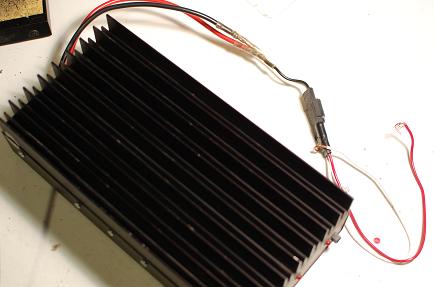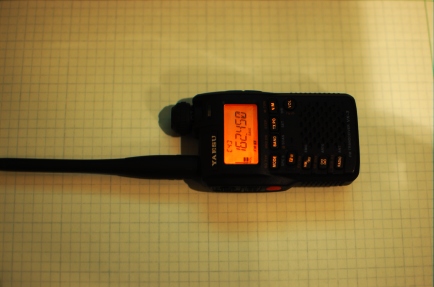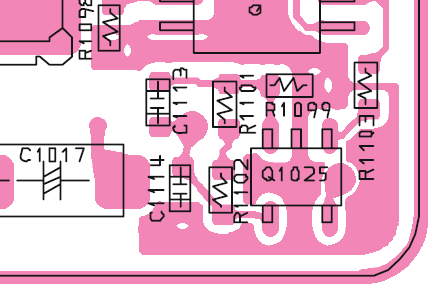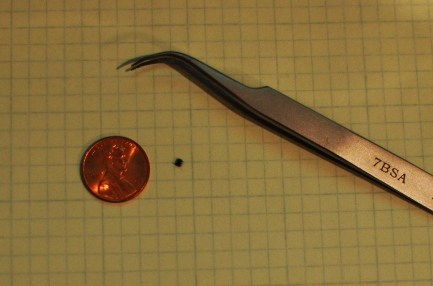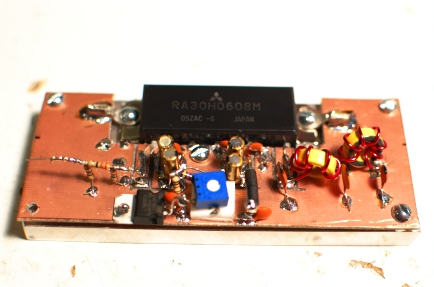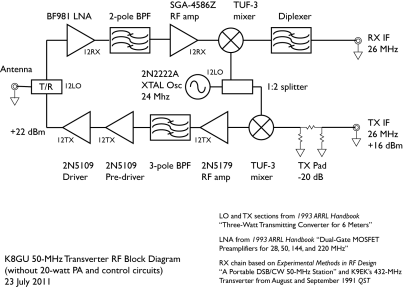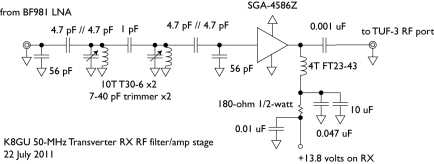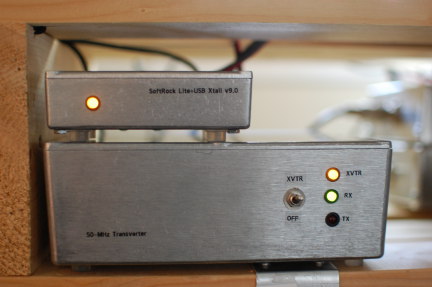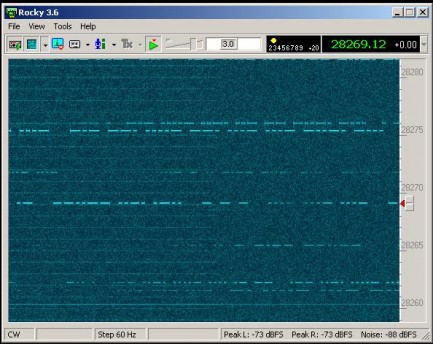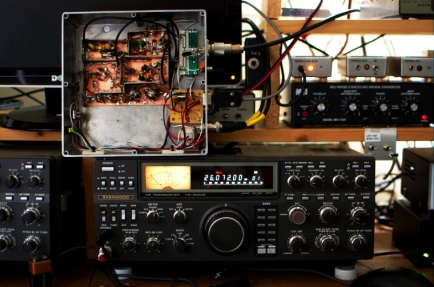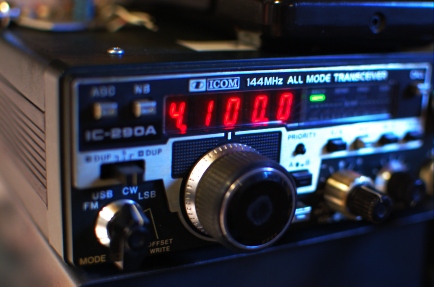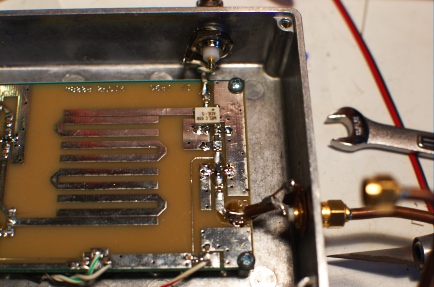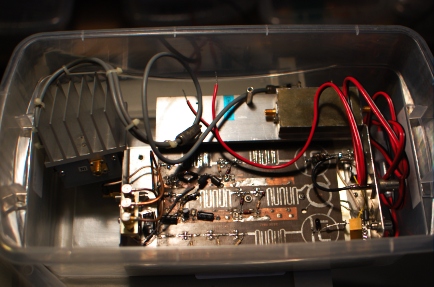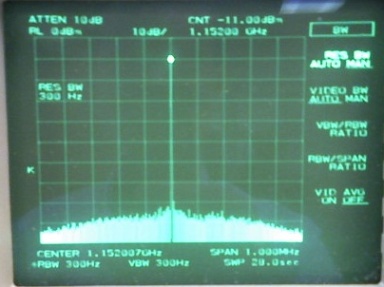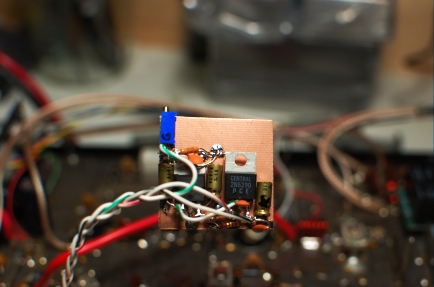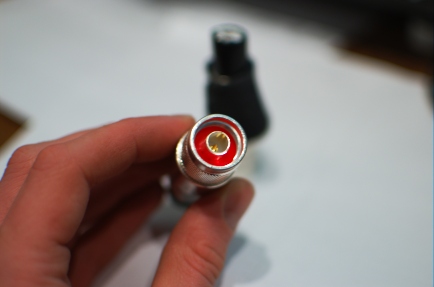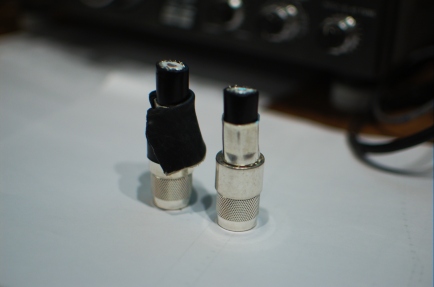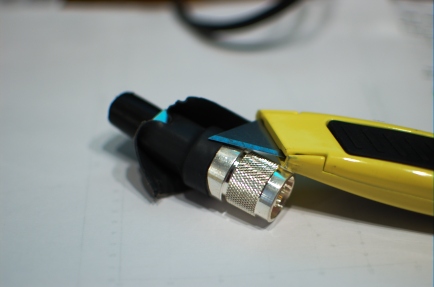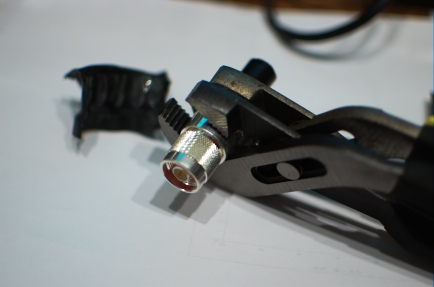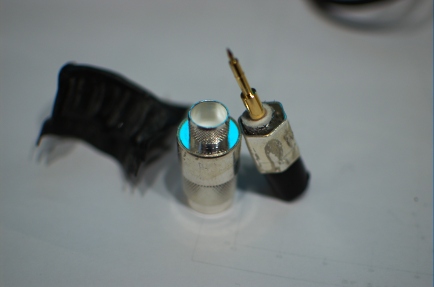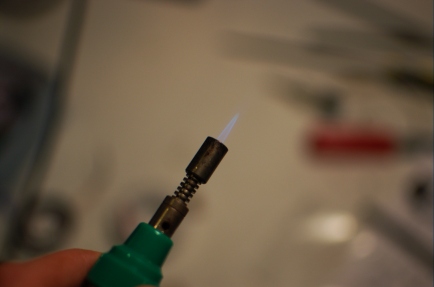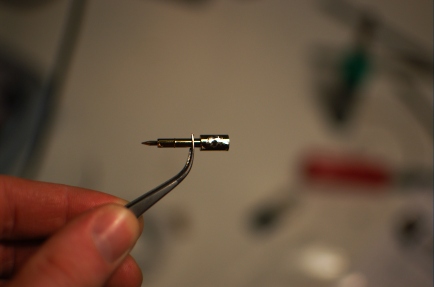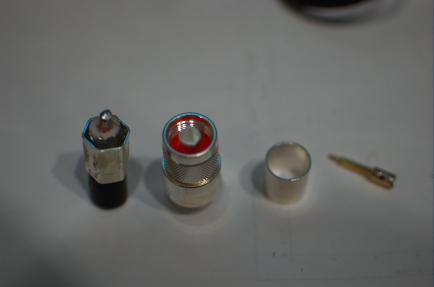I’ve picked up a couple of Mirage “brick” amplifiers over the past few years. I’ve also rewired the DC cable on each and every one. Here’s the latest. AWG 10 to AWG 16 transition? Seriously? I know it technically doesn’t matter too much for a short run, but these amplifiers suck down a lot of current and I just don’t see cutting corners on that. Maybe I’m a purist…
Posts Tagged ‘cheap VHF’
Amateur Wiring
October 13th, 2011A deaf VX-3R
October 12th, 2011I do not spend a lot of time on VHF/UHF FM and have not for many years. My first radio in 1993 was an Alinco DJ-580T handheld and I’ve thought at various times that a new handheld might suit me well, especially for receiving. A few weeks ago, as I tend to, I came across a Yaesu VX-3R offered “for parts or repair” on attractive terms and so acquired it—my second handheld ever. The problem seemed straightforward enough: full TX power, but no RX on amateur bands. RX on FM broadcast OK. The seller assured me, after I had agreed to purchase based on his description, that “somebody” had told him that this problem occurs when “only one component is bad.”
Based on the seller’s description of the problem and a thorough reading of the Technical Supplement, I developed a short list of candidate failure modes, components, and sources. Fortunately, all of the components could be sourced easily from the usual sources.
When the radio arrived, I gave it a functional check and it indeed exhibited the problem that the seller had advertised. I quickly popped it open and noticed a small red sticker in the lower right-hand (when facing the device like you would operate it) corner of the Main Unit (Side A, per the Technical Supplement’s notation). A neatly hand-drawn arrow pointed to component Q1025, which upon closer inspection, was clearly damaged.
So, I quickly set about identifying the component and procuring a replacement. It was a NJU7007F3 operational amplifier. Huh…it did not contribute to any of the failure modes I had initially suspected. However, a careful reading of the Technical Supplement indicated that this op amp drives varactor diodes in a tracking preselector—so, if it does not work, the radio will exhibit varying degrees of deafness in the amateur bands. I found out later that the “somebody” was actually a Yaesu technician who had seen the radio for repair at the behest of a previous owner and left the sticker for me. At any rate, this component clearly would have to be replaced if I were to fix the radio, so I set about looking for a source.
Mouser listed it in their catalog but wanted me to buy a reel of 3000. No thanks. At least they had it listed. So, I did the next most logical thing—I made a list of other parts that I needed and called Yaesu. The part was back-ordered to Japan for 4-6 weeks, but only cost 0.42 USD. I bought three.
After however many weeks it has been, a package from Yaesu showed up on my doorstep tonight. After repairing a damaged PCB trace (non trivial on something this small), I was able to replace it. The little black speck in the middle of this photograph is the removed component. For my non-US readers, the US 0.01 USD coin (“Penny”) is about 19 mm in diameter.
The radio fired right up and received NOAA/NWS right away. The entire repair once I had the parts was about 30 minutes. There are still two unbuilt SoftRock kits, an IC-290A with an unlocking PLL, and W1GHZ transverters for 903 and 1296 to be worked on…maybe tomorrow…
Improving 50-MHz Transmit Capability
July 28th, 2011Over the past week in the evenings, I’ve managed to cobble a little PA together for the 50-MHz transverter. It’s a near-clone of the PA in the Elecraft XV50 using the Mitsubishi RA30H0608M. Last night, I got it all hooked up and installed in the cabinet. It broke into oscillation when keyed on CW.
The oscillation was about 50.040 MHz. I reasoned that it might be the PA output coupling into the nearby TX RF bandpass filters which are followed by 12 dB of gain before returning to the PA. So, tonight, I added a litle shield between the BPF and the PA board. That seemed to clear things up and I got about 10 watts out. There is a 6-dB pad between the last driver stage and the PA, so I should be able to get it up to about 18-20 watts. But, the first goal will be to check the linearity on SSB.
In other transmit capability news, some boxes and heatsinks arrived for the W6PQL PAs for 903 and 1296 this afternoon.
Improving 50-MHz Receive Capability
July 23rd, 2011As I mentioned previously, the receive capability in my 50-MHz transverter seemed to be a little bit anemic. So, I decided to add a little bit of gain. Looking at the block diagram for the transverter (shown below in updated form—jumper across the SGA-4586Z to understand what the circuit looked like initially—by the way, full-sized PDF versions of all of my notes and schematics will eventually be available here), I reasoned that I had the following losses and gains: +10 dB for the LNA (this might be as much as +15 dB, but 10 seems more realistic, if not generous), -3 dB for the bandpass filter, -7 dB for the mixer conversion loss, and -3 dB in the diplexer, leaving me with -3 dB overall conversion gain.
So, I endeavored to find some more gain in the form of a MMIC (which is really what all gain blocks in this transverter would be if I were to do it again). I have a nice (but dwindling) supply of SGA-4586Z’s that produce about 20 dB gain with a 1-dB compression point around 16 dBm, which is probably a good part for this location. The idea is to overcome the losses in following stages with robust gain in earlier stages (in order to keep system NF low). So, I ripped out the existing two-pole BPF and replaced it with this:
I was relatively satisfied that I had everything working with the cover of the transverter off to peak the BPF on the W3APL beacon. So, I replaced the cover and surprise! To borrow a poetic description of RF circuit doom from N3UM, the MMIC “amplifier burst into song.” Bursting into song is a bit of a charitable description for something that sounded more like S9 power line noise in the IF receiver. I did not actually know that it was the MMIC oscillating at first, but I started wiggling cables and finally found that if I touched the 12RX (+13.8 volts on RX) line, the problem disappeared. So, I added the 0.01-uF bypass capacitor to ground on the supply side of 180-ohm bias resistor and the problem was solved.
With the completion of the HF SoftRock with Si570 LO, I now have a tunable IF to play with the transverter. We had a nice opening to the Southeast and Gulf this morning and I even heard my first DX with the transverter and SoftRock combination—CO2WF. With the appropriate software, I can configure a the SoftRock as a panadapter with the TS-930S as the transmitter. More on this in the future. Best of friends:
The real next step in making the transverter useful is building a 20-watt PA stage. This should be good for driving a Mirage or TE Systems brick or even something bigger like a 3CX800 or 50-volt solid-state amp…
SoftRock v9.0 Lite+USB Xtall QRV
July 23rd, 2011Got the SoftRock v9.0 Lite+USB Xtall working last night. I’m not 100% sure what the problem was, but I think it may have been due to me programming an ATTiny85 with the latest SoftRock firmware (V15.14), rather than using the supplied ATTiny45 with V15.4. So, I’m sticking with old version for now. Not sure if it was cockpit error on my part programming (more likely) or an incompatibility with the new firmware which is designed to work with the Ensemble series of SoftRocks.
As shown in the screenshot from Rocky above, there appears to be a spur that repeats every 1 kHz (see left side of the waterfall). The right side of the waterfall is with the USB cable unplugged from the computer. I’m 99% certain this is something internal to the SoftRock because I wrapped a few turns of the USB cable around a big type-31 ferrite toroid and the spurs are still there. So, need to play with that.
I’m listening to a Es opening to the south on 50 MHz right now using the SoftRock as the RX IF. Yes, that means that I got the RX on the transverter souped up a little hotter. I will post something about that later today and place a non-causal link in this post.
Revisiting the 50-MHz Transverter
July 17th, 2011I recently resurrected the 50-MHz transverter project and have made good headway getting it working. On Friday night, I began the process of tapping holes in the PA module heat spreader. But, despite using plenty of “cutting fluid” (3-in-1 oil), I managed to break a (well-used) tap on the first hole. Since the maximum (linear) power out of the driver stage is 200 mW, I embraced my inner QRPer and put the PA project aside to give the transverter a try in the CQ WW VHF contest.
The 6-meter Yagi had come down in favor of Yagis for 222 and 432 when the loaner FT-736R showed up. So, I scampered up onto the roof and moved Yagis around. I had hoped that this moment would be accompanied by changing out RG-8 coax for LMR-600 and LDF4-50A that are taking up space in the shop and shack. But, I was not ready to commit to cutting that and I still don’t have LMR-600UF for the rotator loops. Plus, I should replace the rotator at the same time. That amounted to too much work for the available time. I really just need to bite the bullet and install a rotating mast for the VHF antennas that’s not so precarious.
Got everything hooked up late on Saturday afternoon, but had to tend to some domestic concerns and was QRT until later in the evening when I heard my neighbor W4EE calling CQ on six SSB. Did not know that he had six! Apparently, this is a new thing for him, too. He was surprised that I didn’t vibrate his radio off the desk like I usually do! Told him I was running 200 mW and everything made sense.
Ended up working a few other locals on Sunday including N3UM, who moved me from 6-meter CW to 2-meter SSB for a quick chat. He just completed the N1DPM active bias mod to his Mirage B2518G, so was eager for an audio report. Sounds good! He said my B3016G sounded good on-frequency, but I haven’t gotten the mod actually inserted into mine yet. Probably that Kenwood (TS-700S) audio making up for the amp’s inferiority…
Eventually, I will be posting more details on the circuit here. This is one of those projects that I would not encourage anyone to duplicate as I have constructed it. However, there may be useful features.
Microwave updates
June 25th, 2011Apologies for the bad pun in the title. I was going to call it “Microwave progress” but could help myself when I thought of this one. Here are some notes from tinkering over the past few days.
1296 Mhz
After learning that the 1152-MHz LO power was -11 dBm, I inserted a MAR-3 MMIC on the 1296RSU transverter board. W1GHZ shows an MAR-6 on his board, but the ever-astute N3UM noticed that the P1dB for the MAR-6 is 1 dBm, which is well below the nominal 7 dBm level of the ADE-5 mixer. Unfortunately, the MAR-3 has about 12 dB of gain vs the MAR-6’s 20 dB. A little bit of skullin’ lead me to my stash of SGA-4586’s (suggested as an economical front end by W9SZ), which can do >20 dB gain with a P1dB point of 16 dBm or so. Perfect.
Unfortunately, with an 144-MHz IF drive of about 2 dBm, the 1296-MHz output was totally trashed with various mixing products. I spent about 20 minutes searching frantically for the 3-dB SMA attenuator I’d purchased at Dayton. But, I never found it—a sign that my organizational scheme has lost control or that I never actually bought the attenuator. Either are possible. So, I did the next logical thing—I added a Pi-network attenuator between the SGA-4586 “LO boost” MMIC and the ADE-5 mixer. If the Dremel tool didn’t make it’s inventor independently wealthy, it should have. The only SMD resistors that I had on-hand that were realistically appropriate (39.6 and 130 ohms) yielded about 6-7 dB of attenuation, so the effective gain of the SGA-4586/attenuator cascade was probably around 13-15 dB, yielding somewhere around 2-3 dBm of LO. Blech. That’s essentially the same as the MAR-3. The 1296-MHz output with 2 dBm of drive at 144 Mhz was about 2.5 dBm.
The data sheet for the ADE-5 suggests that the conversion loss increases as the LO drive level falls bellow 7 dBm (shocking!), but there are not enough data to show how precipitously it deteriorates. However, essentially 0.5 dB of overall power gain does not jibe with the amount of gain in the system, which should be closer to 20 dB. From this standpoint, perhaps the mixing products were due to IF overdrive instead of LO overdrive. In any event, about 3 dB (instead of 6 or 7 dB) of attenuation in the LO would be a good thing.
902/903 MHz
Fresh off my mixed success with the W1GHZ 1296RSU (which are neatly packaged in Hammond 1590BB-sized cast aluminum boxes), I wanted to give the 902/903 version (which is still loose boards) a try with the spectrum analyzer. So, I hooked up the 756LO board first. It made -5 dBm at 756 MHz. These numbers are more like what W1GHZ was promising. So, I put the MAR-3 mentioned above onto the 902/903 transverter board. With 2 dBm of 147-MHz drive, the output was a very clean 16 dBm on 903. Score! Must be livin’ right at least half the time. My last DigiKey order included a 1590BB for that transverter, but the 756LO board is a bit longer and I haven’t yet found a suitable case for it.
3456 MHz
Thought I was done? Me too.
I admit it. I’m a sucker for this sort of thing. Fred, N1DPM, recently posted to VHFcontesting and the “Stanford” VHF lists that he was selling a bunch of spare microwave gear, including a first-generation DEMI 3456 transverter/LO and some amplifiers to get the output up to 4 watts. Cheap. He had some 2304 stuff, but ye old project fund is pretty much depleted since Dayton and I always try to keep a little bit in reserve for just this sort of opportunity. Anyhow, the transverter is set up for 10 watts of drive on 144 MHz. I gave it 250 mW (24 dBm) from my modified IC-290A (post to follow on this—not rocket science, just bypassed the PA) and the output came up at -9 dBm on 3456 MHz. Once I remove the attenuator from the input, I should be able to get it up to about 13 dBm. At least it seems to work on TX. Need an antenna to try RX because the K3UO beacons are not as close as W3APL.
W1GHZ 1152-MHz LO measurements
June 22nd, 2011Through some reorganization at work in the past two months, I have suddenly gained ready access to a lab full of RF test equipment again. Two years is a long time to go without. Apologies for the cell-phone photograph of the screen.
I took the W1GHZ 1152-MHz LO board over to have a look at it during lunch. I’m seeing -11 dBm at 1152.007 MHz. I am a bit dubious of the last digit of the frequency (even at 300 Hz RBW) but I’m sure there’s a frequency counter around somewhere. Anyhow, I need to put a MMIC (or two) on the transverter board. That should be a nice evening project along with the W6PQL preamp kit that showed up today.
Mirage Active Bias mod, Part 1
June 9th, 2011After chatting with Terry, W8ZN, about whether to keep or sell the AM-6155s (which I did sell to finance a tower), he suggested that I apply the N1DPM “Active Bias” modification to my elderly “160-watt” Mirage 2-meter amplifier. I contacted Fred, N1DPM, and he sent me a copy of his paper Linearization of Solid State “Brick” Amplifiers from the 21st Eastern VHF/UHF Conference (1995), along with some additional notes from his notebook. It’s pretty eye-opening how non-linear the amp is without the modification! I finally gathered the parts and hacked it together last night. Hope to test it soon with a “dummy” transistor and then live on the amp. The braided wires go to the thermal compensation transistor which is thermally bonded to one of the RF power transistors.
It probably won’t be ready for the ARRL June VHF this weekend, though. So, I’ll only be using the amp on CW. That’s no matter since I haven’t hung the low-loss cable (LMR and Heliax), nor have I received a D1010 432-MHz amp that will be on its way to me soon. Everything seems to take longer than it ought to!
Recycling LMR crimp connectors
June 4th, 2011A while back, I came upon about two dozen Times Microwave Systems TC-600-NM connectors that had been improperly installed and cut off. Knowing that LMR-600 type cable is commonly available, I stashed them for later use. These connectors cost between $8 and $15 each, so the ability to recycle could offer a substantial savings. I endeavored to see just what it would take to do so.
The first step is to remove the heatshrink tubing (if installed). These connectors employed a relatively easy-to-remove heatshrink, which I was able to get off with a sharp knife. (That probably means that they would have filled with water if they had been used.)
Twist off the old crimp ring with two pair of Channel-Lock-type pliers.
Presto! (Be sure to do this in a work area where it is easy to vacuum up the small strands of braid that will invariably fall everywhere.)
A butane torch gets the pin off in no time.
Unfortunately, I did not have enough hands to take a photograph and demonstrate the proper technique. Place the tip of the flame on the widest (diameter) part of the pin and rotate the cut-off coax with the pin hanging down. The solder will melt and the pin will drop. Reinstallation can be performed in the exact opposite sequence with the pin sitting on top of the coax.
The secret to this whole operation is the replacement crimp rings. I originally was going to make them but since I did not know the dimensions, I was searching around the Web. And, I discovered that Times Microwave offers them individually (part #CR-600). So, I contacted Joel at The RF Connection and he sold me a bunch of them (second from right below) at an attractive price.
The three rightmost components—connector body, crimp ring, and solder pin, form a complete connector. You just need to add heatshrink, which is also available from the RF Connection and many other vendors. The trick to getting a correct installation on the connectors is to be sure that the pin seats (clicks) into the body before crimping the ring. The whole process of disassembly takes about as long as assembly (minus the stripping step)—just a few minutes.
I recently obtained about 250 ft (80 m) of LMR-600 pieces from various places for about what it costs to fill the gas tank in my Escort. So, this should be a relatively attractive cable for use at K8GU.
